Australian Taxation Law Report: Small Business Tax Incentives Analysis
VerifiedAdded on 2020/05/16
|12
|2594
|97
Report
AI Summary
This report delves into the intricacies of Australian taxation law, with a specific emphasis on tax incentives designed to support small businesses. It begins by defining research and development and the tax incentives available, including both refundable and non-refundable tax offsets. The report then explores the implications of these incentives, highlighting their positive impact on business performance, increased participation in research activities, and improvements in operational efficiency. A significant portion of the report is dedicated to examining the provisions of taxation law, particularly those outlined in the Income Tax Assessment Act 1936 and TR 92/2, which detail the conditions and rules that businesses must adhere to in order to qualify for tax incentives. The report further categorizes allowable expenditures and concludes by emphasizing the importance of these incentives in fostering innovation and long-term value creation for businesses.
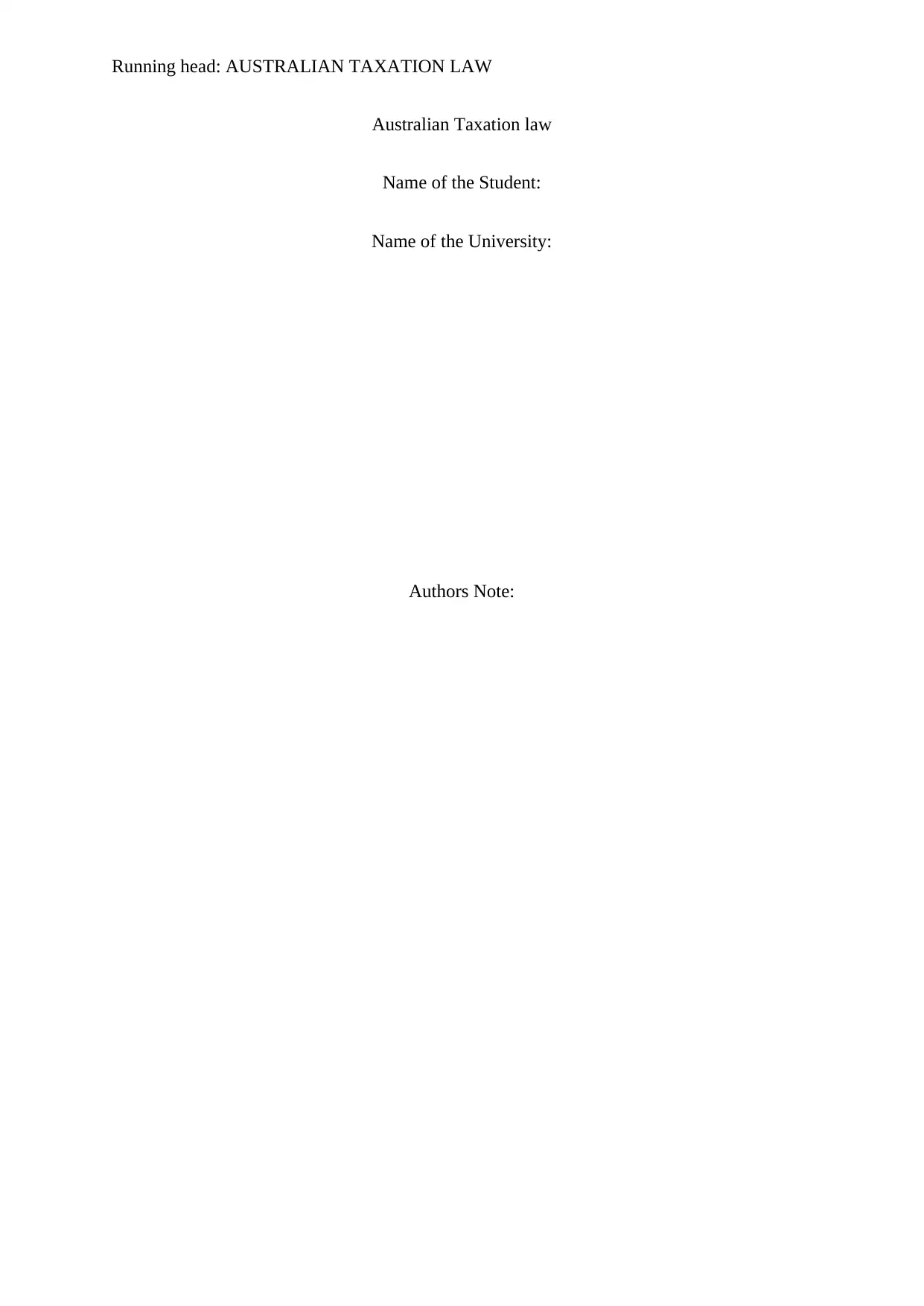
Running head: AUSTRALIAN TAXATION LAW
Australian Taxation law
Name of the Student:
Name of the University:
Authors Note:
Australian Taxation law
Name of the Student:
Name of the University:
Authors Note:
Paraphrase This Document
Need a fresh take? Get an instant paraphrase of this document with our AI Paraphraser
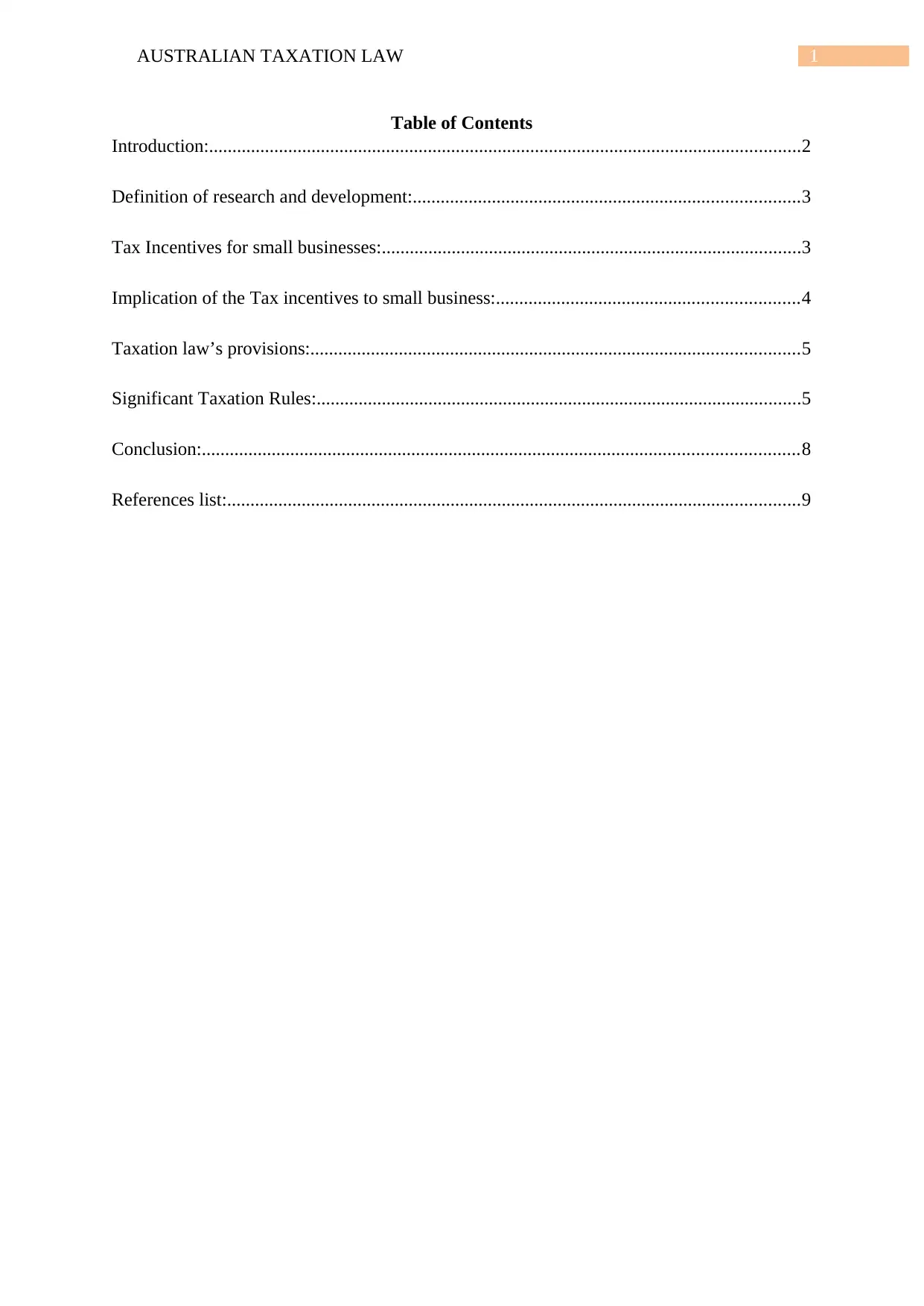
1AUSTRALIAN TAXATION LAW
Table of Contents
Introduction:...............................................................................................................................2
Definition of research and development:...................................................................................3
Tax Incentives for small businesses:..........................................................................................3
Implication of the Tax incentives to small business:.................................................................4
Taxation law’s provisions:.........................................................................................................5
Significant Taxation Rules:........................................................................................................5
Conclusion:................................................................................................................................8
References list:...........................................................................................................................9
Table of Contents
Introduction:...............................................................................................................................2
Definition of research and development:...................................................................................3
Tax Incentives for small businesses:..........................................................................................3
Implication of the Tax incentives to small business:.................................................................4
Taxation law’s provisions:.........................................................................................................5
Significant Taxation Rules:........................................................................................................5
Conclusion:................................................................................................................................8
References list:...........................................................................................................................9
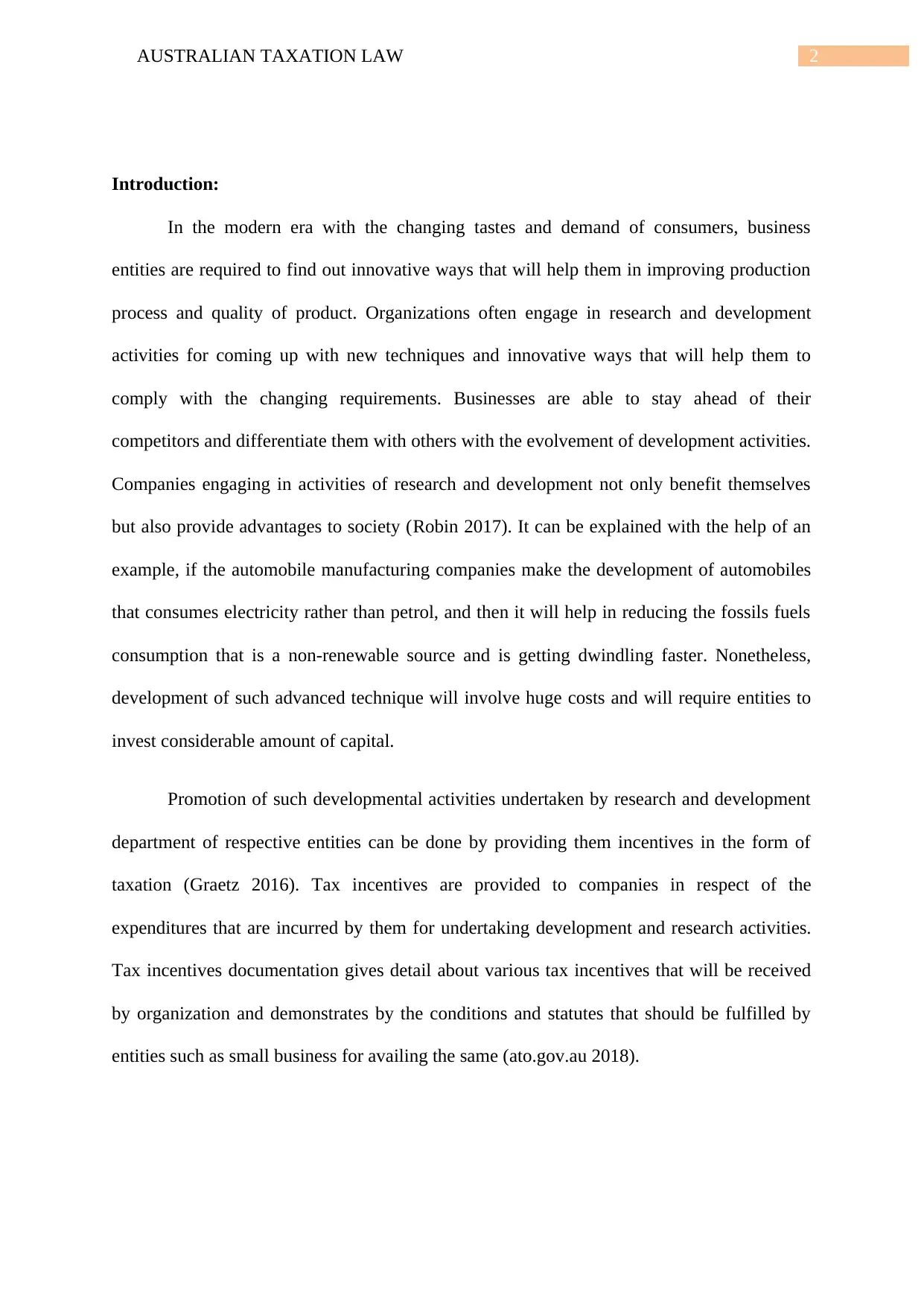
2AUSTRALIAN TAXATION LAW
Introduction:
In the modern era with the changing tastes and demand of consumers, business
entities are required to find out innovative ways that will help them in improving production
process and quality of product. Organizations often engage in research and development
activities for coming up with new techniques and innovative ways that will help them to
comply with the changing requirements. Businesses are able to stay ahead of their
competitors and differentiate them with others with the evolvement of development activities.
Companies engaging in activities of research and development not only benefit themselves
but also provide advantages to society (Robin 2017). It can be explained with the help of an
example, if the automobile manufacturing companies make the development of automobiles
that consumes electricity rather than petrol, and then it will help in reducing the fossils fuels
consumption that is a non-renewable source and is getting dwindling faster. Nonetheless,
development of such advanced technique will involve huge costs and will require entities to
invest considerable amount of capital.
Promotion of such developmental activities undertaken by research and development
department of respective entities can be done by providing them incentives in the form of
taxation (Graetz 2016). Tax incentives are provided to companies in respect of the
expenditures that are incurred by them for undertaking development and research activities.
Tax incentives documentation gives detail about various tax incentives that will be received
by organization and demonstrates by the conditions and statutes that should be fulfilled by
entities such as small business for availing the same (ato.gov.au 2018).
Introduction:
In the modern era with the changing tastes and demand of consumers, business
entities are required to find out innovative ways that will help them in improving production
process and quality of product. Organizations often engage in research and development
activities for coming up with new techniques and innovative ways that will help them to
comply with the changing requirements. Businesses are able to stay ahead of their
competitors and differentiate them with others with the evolvement of development activities.
Companies engaging in activities of research and development not only benefit themselves
but also provide advantages to society (Robin 2017). It can be explained with the help of an
example, if the automobile manufacturing companies make the development of automobiles
that consumes electricity rather than petrol, and then it will help in reducing the fossils fuels
consumption that is a non-renewable source and is getting dwindling faster. Nonetheless,
development of such advanced technique will involve huge costs and will require entities to
invest considerable amount of capital.
Promotion of such developmental activities undertaken by research and development
department of respective entities can be done by providing them incentives in the form of
taxation (Graetz 2016). Tax incentives are provided to companies in respect of the
expenditures that are incurred by them for undertaking development and research activities.
Tax incentives documentation gives detail about various tax incentives that will be received
by organization and demonstrates by the conditions and statutes that should be fulfilled by
entities such as small business for availing the same (ato.gov.au 2018).
⊘ This is a preview!⊘
Do you want full access?
Subscribe today to unlock all pages.

Trusted by 1+ million students worldwide

3AUSTRALIAN TAXATION LAW
Definition of research and development:
Research and development refers to all such activities that are undertaken by company
for the acquisition of new knowledge that will help them in innovating their products. Such
activities require organization to make investments in advanced technologies and make use
system, process and technology. The current capacity utilization of company is utilized in
best forms with the help of research activities that help them in delivering best to customers
and serving society at the same time.
Tax Incentives for small businesses:
The concession given to small business in reference to their research and development
activities starting before 1st July, percentage stands at 125%. In some other circumstance, the
percentage of tax incentives received by organization can exceed 175% (ato.gov.au 2018).
For the purpose of motivating and encouraging companies to involve in the research and
development activities, various tax incentives are provided as per statues. Companies are
encouraged to undertake research and development activities if they are provided with the
incentives relating to taxation. Tax incentives for research and development involve two
components and this includes a refundable tax offsets and non-refundable tax offsets
(Barkoczy 2016). The two components of tax incentives are listed below and are as follows:
A non refundable tax offset of 38.5% to all eligible entities
For some certain eligible entities, taxation authority provides a refundable tax offset
of 43.5% and the turnover of company should not be more than 20 million (ato.gov.au
2018).
Statue has reduced the tax offset on research and development activities undertaken by
company to 30% and the rate has been effective from 1st July 2004 and will remain till 1st July
2024 (ato.gov.au 2018).
Definition of research and development:
Research and development refers to all such activities that are undertaken by company
for the acquisition of new knowledge that will help them in innovating their products. Such
activities require organization to make investments in advanced technologies and make use
system, process and technology. The current capacity utilization of company is utilized in
best forms with the help of research activities that help them in delivering best to customers
and serving society at the same time.
Tax Incentives for small businesses:
The concession given to small business in reference to their research and development
activities starting before 1st July, percentage stands at 125%. In some other circumstance, the
percentage of tax incentives received by organization can exceed 175% (ato.gov.au 2018).
For the purpose of motivating and encouraging companies to involve in the research and
development activities, various tax incentives are provided as per statues. Companies are
encouraged to undertake research and development activities if they are provided with the
incentives relating to taxation. Tax incentives for research and development involve two
components and this includes a refundable tax offsets and non-refundable tax offsets
(Barkoczy 2016). The two components of tax incentives are listed below and are as follows:
A non refundable tax offset of 38.5% to all eligible entities
For some certain eligible entities, taxation authority provides a refundable tax offset
of 43.5% and the turnover of company should not be more than 20 million (ato.gov.au
2018).
Statue has reduced the tax offset on research and development activities undertaken by
company to 30% and the rate has been effective from 1st July 2004 and will remain till 1st July
2024 (ato.gov.au 2018).
Paraphrase This Document
Need a fresh take? Get an instant paraphrase of this document with our AI Paraphraser
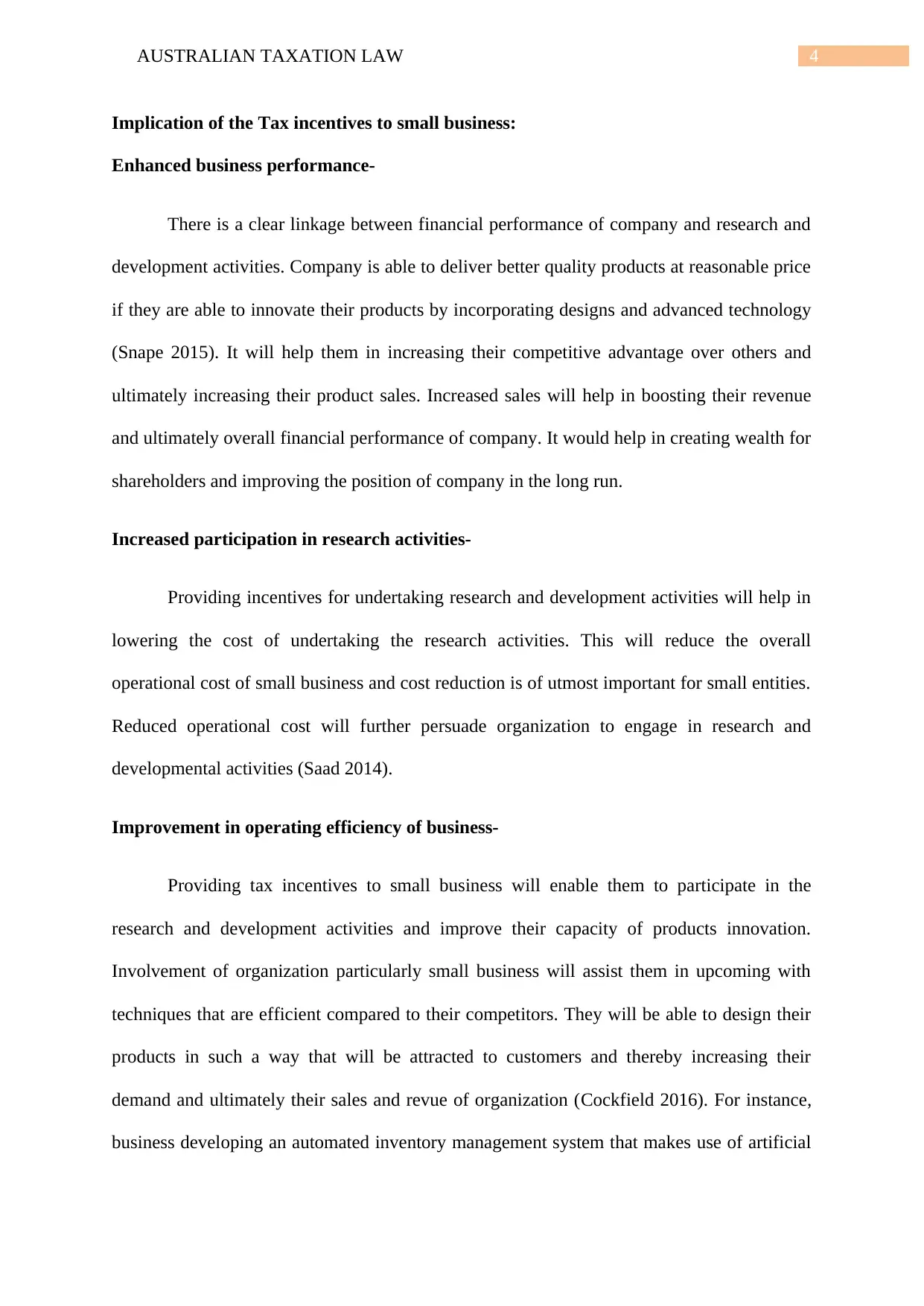
4AUSTRALIAN TAXATION LAW
Implication of the Tax incentives to small business:
Enhanced business performance-
There is a clear linkage between financial performance of company and research and
development activities. Company is able to deliver better quality products at reasonable price
if they are able to innovate their products by incorporating designs and advanced technology
(Snape 2015). It will help them in increasing their competitive advantage over others and
ultimately increasing their product sales. Increased sales will help in boosting their revenue
and ultimately overall financial performance of company. It would help in creating wealth for
shareholders and improving the position of company in the long run.
Increased participation in research activities-
Providing incentives for undertaking research and development activities will help in
lowering the cost of undertaking the research activities. This will reduce the overall
operational cost of small business and cost reduction is of utmost important for small entities.
Reduced operational cost will further persuade organization to engage in research and
developmental activities (Saad 2014).
Improvement in operating efficiency of business-
Providing tax incentives to small business will enable them to participate in the
research and development activities and improve their capacity of products innovation.
Involvement of organization particularly small business will assist them in upcoming with
techniques that are efficient compared to their competitors. They will be able to design their
products in such a way that will be attracted to customers and thereby increasing their
demand and ultimately their sales and revue of organization (Cockfield 2016). For instance,
business developing an automated inventory management system that makes use of artificial
Implication of the Tax incentives to small business:
Enhanced business performance-
There is a clear linkage between financial performance of company and research and
development activities. Company is able to deliver better quality products at reasonable price
if they are able to innovate their products by incorporating designs and advanced technology
(Snape 2015). It will help them in increasing their competitive advantage over others and
ultimately increasing their product sales. Increased sales will help in boosting their revenue
and ultimately overall financial performance of company. It would help in creating wealth for
shareholders and improving the position of company in the long run.
Increased participation in research activities-
Providing incentives for undertaking research and development activities will help in
lowering the cost of undertaking the research activities. This will reduce the overall
operational cost of small business and cost reduction is of utmost important for small entities.
Reduced operational cost will further persuade organization to engage in research and
developmental activities (Saad 2014).
Improvement in operating efficiency of business-
Providing tax incentives to small business will enable them to participate in the
research and development activities and improve their capacity of products innovation.
Involvement of organization particularly small business will assist them in upcoming with
techniques that are efficient compared to their competitors. They will be able to design their
products in such a way that will be attracted to customers and thereby increasing their
demand and ultimately their sales and revue of organization (Cockfield 2016). For instance,
business developing an automated inventory management system that makes use of artificial
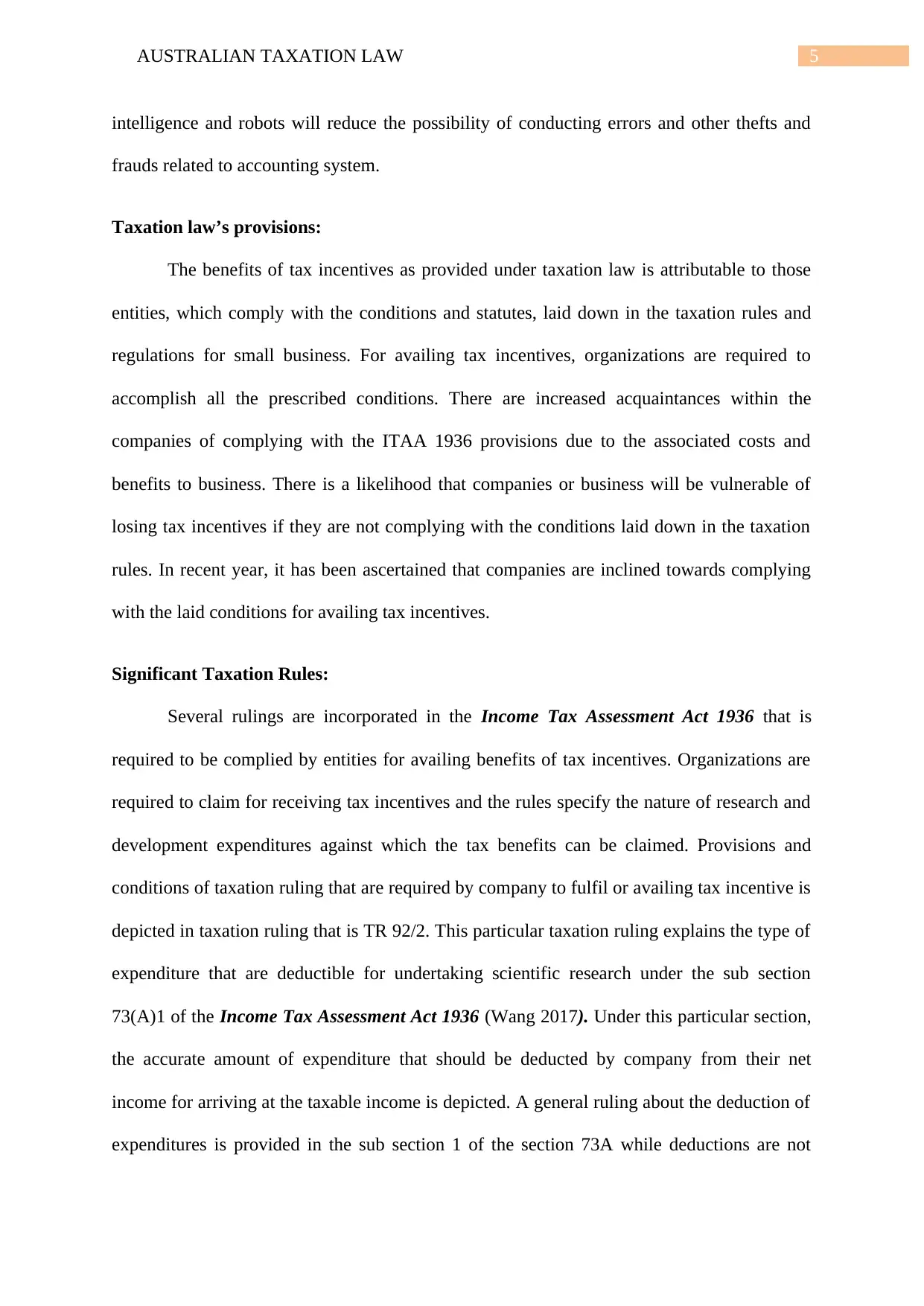
5AUSTRALIAN TAXATION LAW
intelligence and robots will reduce the possibility of conducting errors and other thefts and
frauds related to accounting system.
Taxation law’s provisions:
The benefits of tax incentives as provided under taxation law is attributable to those
entities, which comply with the conditions and statutes, laid down in the taxation rules and
regulations for small business. For availing tax incentives, organizations are required to
accomplish all the prescribed conditions. There are increased acquaintances within the
companies of complying with the ITAA 1936 provisions due to the associated costs and
benefits to business. There is a likelihood that companies or business will be vulnerable of
losing tax incentives if they are not complying with the conditions laid down in the taxation
rules. In recent year, it has been ascertained that companies are inclined towards complying
with the laid conditions for availing tax incentives.
Significant Taxation Rules:
Several rulings are incorporated in the Income Tax Assessment Act 1936 that is
required to be complied by entities for availing benefits of tax incentives. Organizations are
required to claim for receiving tax incentives and the rules specify the nature of research and
development expenditures against which the tax benefits can be claimed. Provisions and
conditions of taxation ruling that are required by company to fulfil or availing tax incentive is
depicted in taxation ruling that is TR 92/2. This particular taxation ruling explains the type of
expenditure that are deductible for undertaking scientific research under the sub section
73(A)1 of the Income Tax Assessment Act 1936 (Wang 2017). Under this particular section,
the accurate amount of expenditure that should be deducted by company from their net
income for arriving at the taxable income is depicted. A general ruling about the deduction of
expenditures is provided in the sub section 1 of the section 73A while deductions are not
intelligence and robots will reduce the possibility of conducting errors and other thefts and
frauds related to accounting system.
Taxation law’s provisions:
The benefits of tax incentives as provided under taxation law is attributable to those
entities, which comply with the conditions and statutes, laid down in the taxation rules and
regulations for small business. For availing tax incentives, organizations are required to
accomplish all the prescribed conditions. There are increased acquaintances within the
companies of complying with the ITAA 1936 provisions due to the associated costs and
benefits to business. There is a likelihood that companies or business will be vulnerable of
losing tax incentives if they are not complying with the conditions laid down in the taxation
rules. In recent year, it has been ascertained that companies are inclined towards complying
with the laid conditions for availing tax incentives.
Significant Taxation Rules:
Several rulings are incorporated in the Income Tax Assessment Act 1936 that is
required to be complied by entities for availing benefits of tax incentives. Organizations are
required to claim for receiving tax incentives and the rules specify the nature of research and
development expenditures against which the tax benefits can be claimed. Provisions and
conditions of taxation ruling that are required by company to fulfil or availing tax incentive is
depicted in taxation ruling that is TR 92/2. This particular taxation ruling explains the type of
expenditure that are deductible for undertaking scientific research under the sub section
73(A)1 of the Income Tax Assessment Act 1936 (Wang 2017). Under this particular section,
the accurate amount of expenditure that should be deducted by company from their net
income for arriving at the taxable income is depicted. A general ruling about the deduction of
expenditures is provided in the sub section 1 of the section 73A while deductions are not
⊘ This is a preview!⊘
Do you want full access?
Subscribe today to unlock all pages.

Trusted by 1+ million students worldwide
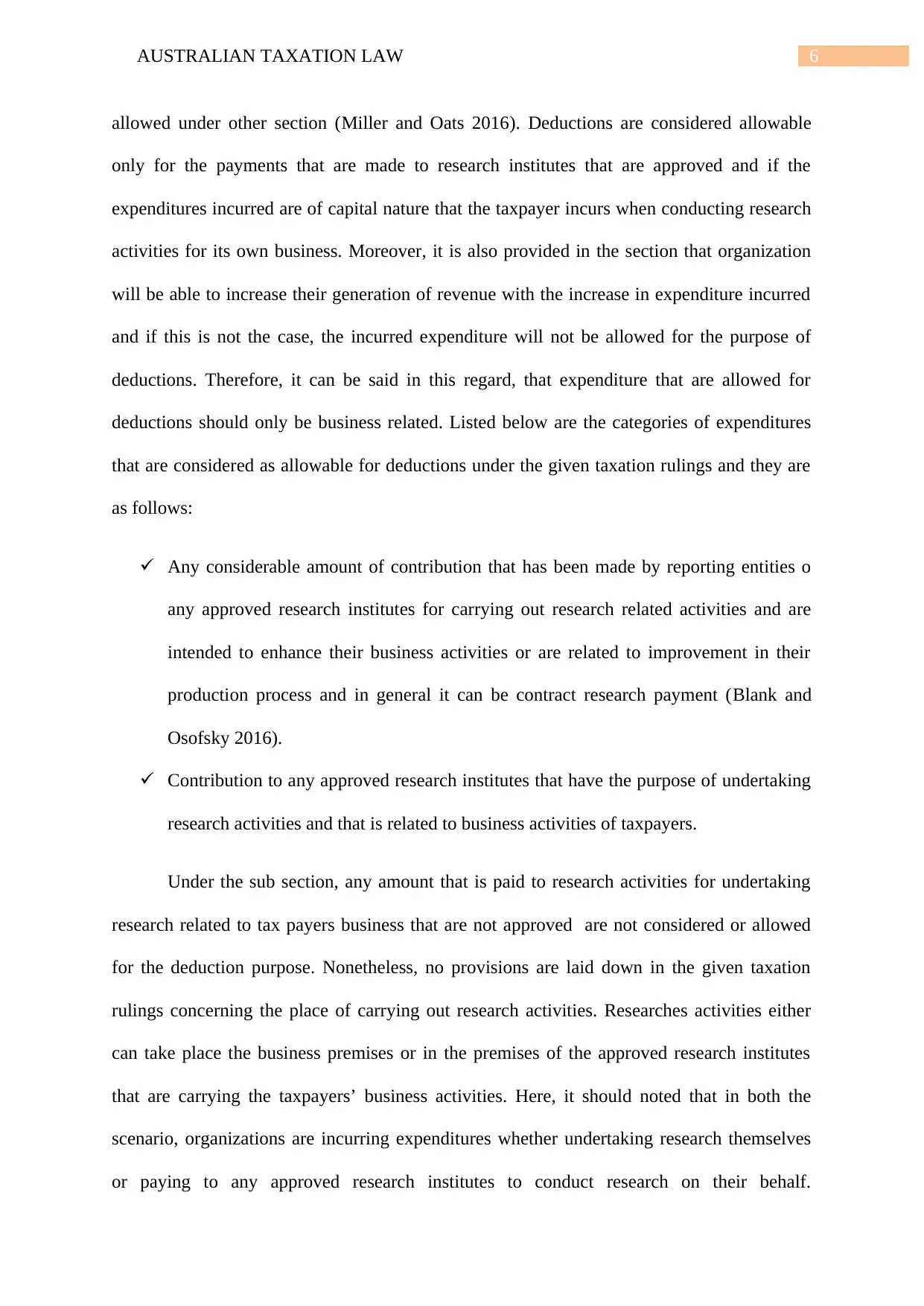
6AUSTRALIAN TAXATION LAW
allowed under other section (Miller and Oats 2016). Deductions are considered allowable
only for the payments that are made to research institutes that are approved and if the
expenditures incurred are of capital nature that the taxpayer incurs when conducting research
activities for its own business. Moreover, it is also provided in the section that organization
will be able to increase their generation of revenue with the increase in expenditure incurred
and if this is not the case, the incurred expenditure will not be allowed for the purpose of
deductions. Therefore, it can be said in this regard, that expenditure that are allowed for
deductions should only be business related. Listed below are the categories of expenditures
that are considered as allowable for deductions under the given taxation rulings and they are
as follows:
Any considerable amount of contribution that has been made by reporting entities o
any approved research institutes for carrying out research related activities and are
intended to enhance their business activities or are related to improvement in their
production process and in general it can be contract research payment (Blank and
Osofsky 2016).
Contribution to any approved research institutes that have the purpose of undertaking
research activities and that is related to business activities of taxpayers.
Under the sub section, any amount that is paid to research activities for undertaking
research related to tax payers business that are not approved are not considered or allowed
for the deduction purpose. Nonetheless, no provisions are laid down in the given taxation
rulings concerning the place of carrying out research activities. Researches activities either
can take place the business premises or in the premises of the approved research institutes
that are carrying the taxpayers’ business activities. Here, it should noted that in both the
scenario, organizations are incurring expenditures whether undertaking research themselves
or paying to any approved research institutes to conduct research on their behalf.
allowed under other section (Miller and Oats 2016). Deductions are considered allowable
only for the payments that are made to research institutes that are approved and if the
expenditures incurred are of capital nature that the taxpayer incurs when conducting research
activities for its own business. Moreover, it is also provided in the section that organization
will be able to increase their generation of revenue with the increase in expenditure incurred
and if this is not the case, the incurred expenditure will not be allowed for the purpose of
deductions. Therefore, it can be said in this regard, that expenditure that are allowed for
deductions should only be business related. Listed below are the categories of expenditures
that are considered as allowable for deductions under the given taxation rulings and they are
as follows:
Any considerable amount of contribution that has been made by reporting entities o
any approved research institutes for carrying out research related activities and are
intended to enhance their business activities or are related to improvement in their
production process and in general it can be contract research payment (Blank and
Osofsky 2016).
Contribution to any approved research institutes that have the purpose of undertaking
research activities and that is related to business activities of taxpayers.
Under the sub section, any amount that is paid to research activities for undertaking
research related to tax payers business that are not approved are not considered or allowed
for the deduction purpose. Nonetheless, no provisions are laid down in the given taxation
rulings concerning the place of carrying out research activities. Researches activities either
can take place the business premises or in the premises of the approved research institutes
that are carrying the taxpayers’ business activities. Here, it should noted that in both the
scenario, organizations are incurring expenditures whether undertaking research themselves
or paying to any approved research institutes to conduct research on their behalf.
Paraphrase This Document
Need a fresh take? Get an instant paraphrase of this document with our AI Paraphraser
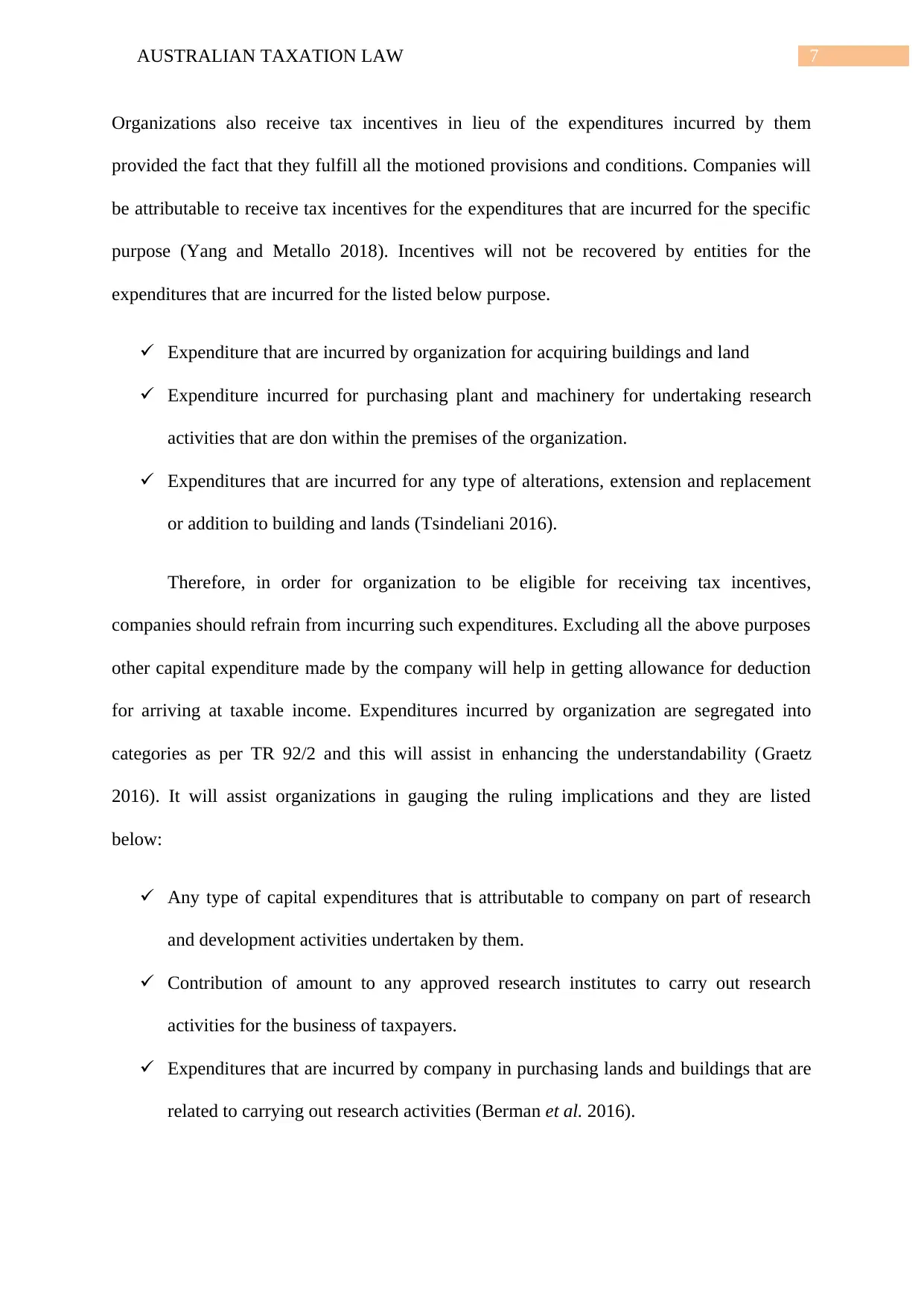
7AUSTRALIAN TAXATION LAW
Organizations also receive tax incentives in lieu of the expenditures incurred by them
provided the fact that they fulfill all the motioned provisions and conditions. Companies will
be attributable to receive tax incentives for the expenditures that are incurred for the specific
purpose (Yang and Metallo 2018). Incentives will not be recovered by entities for the
expenditures that are incurred for the listed below purpose.
Expenditure that are incurred by organization for acquiring buildings and land
Expenditure incurred for purchasing plant and machinery for undertaking research
activities that are don within the premises of the organization.
Expenditures that are incurred for any type of alterations, extension and replacement
or addition to building and lands (Tsindeliani 2016).
Therefore, in order for organization to be eligible for receiving tax incentives,
companies should refrain from incurring such expenditures. Excluding all the above purposes
other capital expenditure made by the company will help in getting allowance for deduction
for arriving at taxable income. Expenditures incurred by organization are segregated into
categories as per TR 92/2 and this will assist in enhancing the understandability (Graetz
2016). It will assist organizations in gauging the ruling implications and they are listed
below:
Any type of capital expenditures that is attributable to company on part of research
and development activities undertaken by them.
Contribution of amount to any approved research institutes to carry out research
activities for the business of taxpayers.
Expenditures that are incurred by company in purchasing lands and buildings that are
related to carrying out research activities (Berman et al. 2016).
Organizations also receive tax incentives in lieu of the expenditures incurred by them
provided the fact that they fulfill all the motioned provisions and conditions. Companies will
be attributable to receive tax incentives for the expenditures that are incurred for the specific
purpose (Yang and Metallo 2018). Incentives will not be recovered by entities for the
expenditures that are incurred for the listed below purpose.
Expenditure that are incurred by organization for acquiring buildings and land
Expenditure incurred for purchasing plant and machinery for undertaking research
activities that are don within the premises of the organization.
Expenditures that are incurred for any type of alterations, extension and replacement
or addition to building and lands (Tsindeliani 2016).
Therefore, in order for organization to be eligible for receiving tax incentives,
companies should refrain from incurring such expenditures. Excluding all the above purposes
other capital expenditure made by the company will help in getting allowance for deduction
for arriving at taxable income. Expenditures incurred by organization are segregated into
categories as per TR 92/2 and this will assist in enhancing the understandability (Graetz
2016). It will assist organizations in gauging the ruling implications and they are listed
below:
Any type of capital expenditures that is attributable to company on part of research
and development activities undertaken by them.
Contribution of amount to any approved research institutes to carry out research
activities for the business of taxpayers.
Expenditures that are incurred by company in purchasing lands and buildings that are
related to carrying out research activities (Berman et al. 2016).
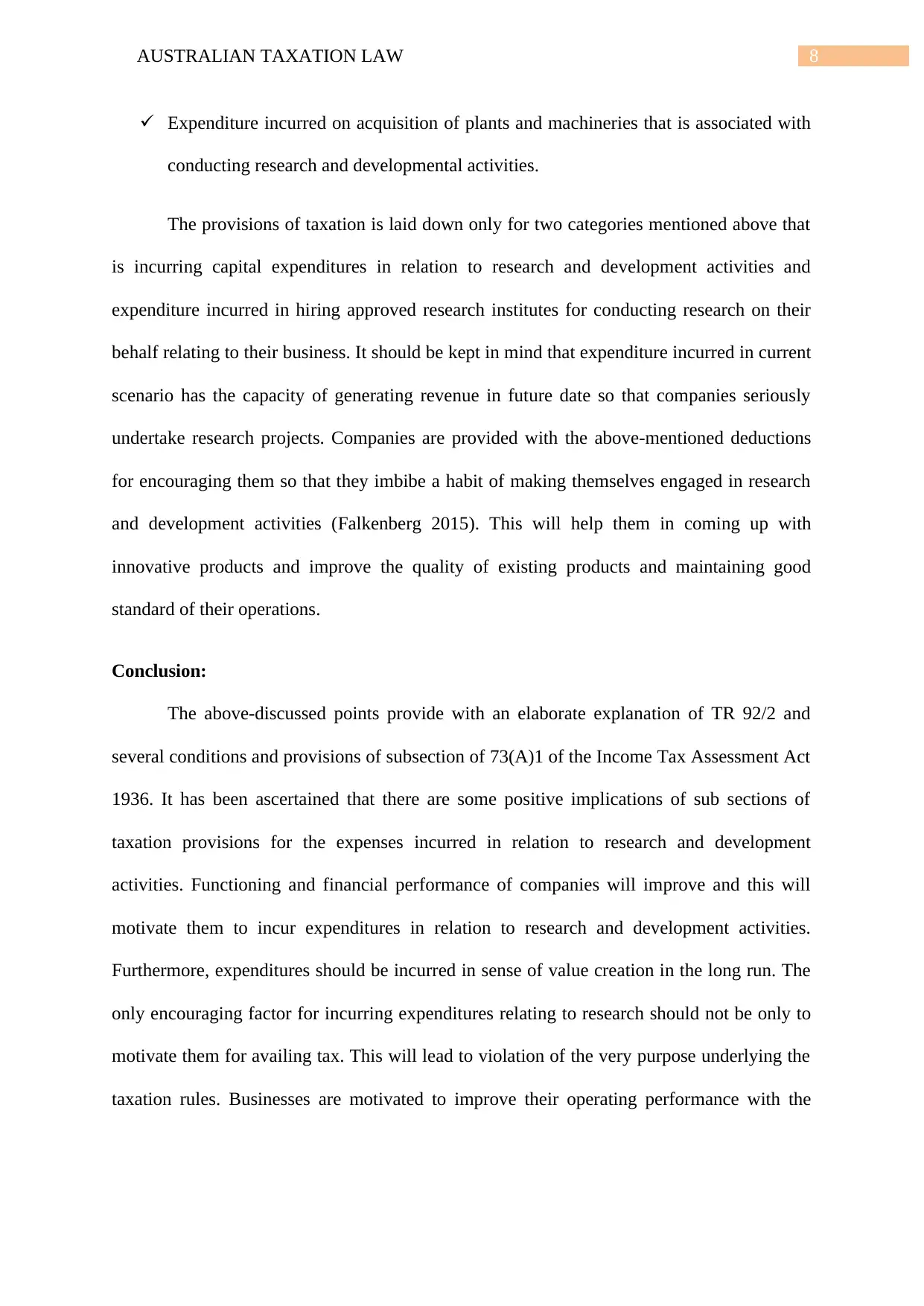
8AUSTRALIAN TAXATION LAW
Expenditure incurred on acquisition of plants and machineries that is associated with
conducting research and developmental activities.
The provisions of taxation is laid down only for two categories mentioned above that
is incurring capital expenditures in relation to research and development activities and
expenditure incurred in hiring approved research institutes for conducting research on their
behalf relating to their business. It should be kept in mind that expenditure incurred in current
scenario has the capacity of generating revenue in future date so that companies seriously
undertake research projects. Companies are provided with the above-mentioned deductions
for encouraging them so that they imbibe a habit of making themselves engaged in research
and development activities (Falkenberg 2015). This will help them in coming up with
innovative products and improve the quality of existing products and maintaining good
standard of their operations.
Conclusion:
The above-discussed points provide with an elaborate explanation of TR 92/2 and
several conditions and provisions of subsection of 73(A)1 of the Income Tax Assessment Act
1936. It has been ascertained that there are some positive implications of sub sections of
taxation provisions for the expenses incurred in relation to research and development
activities. Functioning and financial performance of companies will improve and this will
motivate them to incur expenditures in relation to research and development activities.
Furthermore, expenditures should be incurred in sense of value creation in the long run. The
only encouraging factor for incurring expenditures relating to research should not be only to
motivate them for availing tax. This will lead to violation of the very purpose underlying the
taxation rules. Businesses are motivated to improve their operating performance with the
Expenditure incurred on acquisition of plants and machineries that is associated with
conducting research and developmental activities.
The provisions of taxation is laid down only for two categories mentioned above that
is incurring capital expenditures in relation to research and development activities and
expenditure incurred in hiring approved research institutes for conducting research on their
behalf relating to their business. It should be kept in mind that expenditure incurred in current
scenario has the capacity of generating revenue in future date so that companies seriously
undertake research projects. Companies are provided with the above-mentioned deductions
for encouraging them so that they imbibe a habit of making themselves engaged in research
and development activities (Falkenberg 2015). This will help them in coming up with
innovative products and improve the quality of existing products and maintaining good
standard of their operations.
Conclusion:
The above-discussed points provide with an elaborate explanation of TR 92/2 and
several conditions and provisions of subsection of 73(A)1 of the Income Tax Assessment Act
1936. It has been ascertained that there are some positive implications of sub sections of
taxation provisions for the expenses incurred in relation to research and development
activities. Functioning and financial performance of companies will improve and this will
motivate them to incur expenditures in relation to research and development activities.
Furthermore, expenditures should be incurred in sense of value creation in the long run. The
only encouraging factor for incurring expenditures relating to research should not be only to
motivate them for availing tax. This will lead to violation of the very purpose underlying the
taxation rules. Businesses are motivated to improve their operating performance with the
⊘ This is a preview!⊘
Do you want full access?
Subscribe today to unlock all pages.

Trusted by 1+ million students worldwide

9AUSTRALIAN TAXATION LAW
benefits of tax incentives. Nevertheless, companies for receiving appropriate tax benefits
should comply with all the provisions and conditions laid down in the taxation rulings.
benefits of tax incentives. Nevertheless, companies for receiving appropriate tax benefits
should comply with all the provisions and conditions laid down in the taxation rulings.
Paraphrase This Document
Need a fresh take? Get an instant paraphrase of this document with our AI Paraphraser
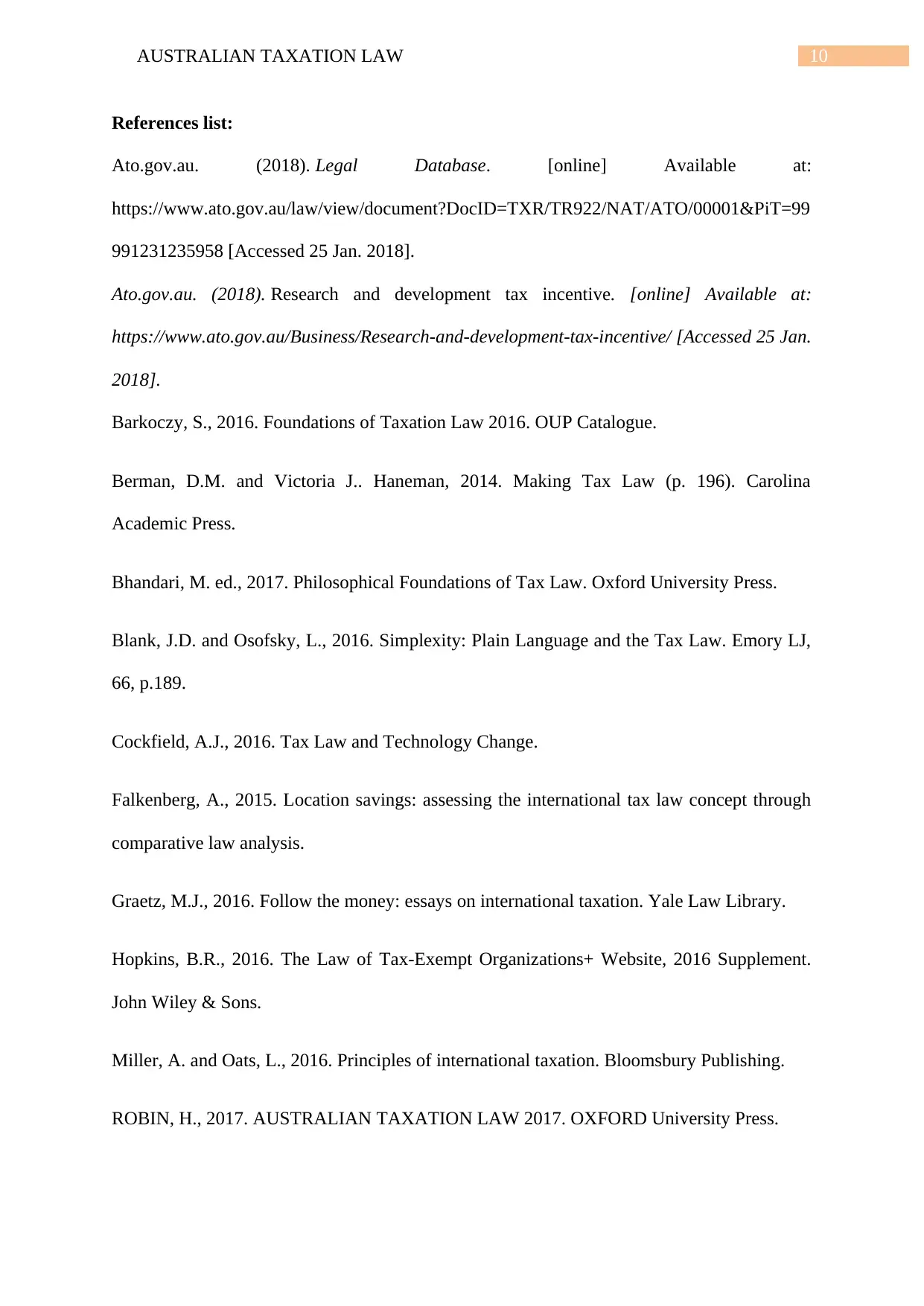
10AUSTRALIAN TAXATION LAW
References list:
Ato.gov.au. (2018). Legal Database. [online] Available at:
https://www.ato.gov.au/law/view/document?DocID=TXR/TR922/NAT/ATO/00001&PiT=99
991231235958 [Accessed 25 Jan. 2018].
Ato.gov.au. (2018). Research and development tax incentive. [online] Available at:
https://www.ato.gov.au/Business/Research-and-development-tax-incentive/ [Accessed 25 Jan.
2018].
Barkoczy, S., 2016. Foundations of Taxation Law 2016. OUP Catalogue.
Berman, D.M. and Victoria J.. Haneman, 2014. Making Tax Law (p. 196). Carolina
Academic Press.
Bhandari, M. ed., 2017. Philosophical Foundations of Tax Law. Oxford University Press.
Blank, J.D. and Osofsky, L., 2016. Simplexity: Plain Language and the Tax Law. Emory LJ,
66, p.189.
Cockfield, A.J., 2016. Tax Law and Technology Change.
Falkenberg, A., 2015. Location savings: assessing the international tax law concept through
comparative law analysis.
Graetz, M.J., 2016. Follow the money: essays on international taxation. Yale Law Library.
Hopkins, B.R., 2016. The Law of Tax-Exempt Organizations+ Website, 2016 Supplement.
John Wiley & Sons.
Miller, A. and Oats, L., 2016. Principles of international taxation. Bloomsbury Publishing.
ROBIN, H., 2017. AUSTRALIAN TAXATION LAW 2017. OXFORD University Press.
References list:
Ato.gov.au. (2018). Legal Database. [online] Available at:
https://www.ato.gov.au/law/view/document?DocID=TXR/TR922/NAT/ATO/00001&PiT=99
991231235958 [Accessed 25 Jan. 2018].
Ato.gov.au. (2018). Research and development tax incentive. [online] Available at:
https://www.ato.gov.au/Business/Research-and-development-tax-incentive/ [Accessed 25 Jan.
2018].
Barkoczy, S., 2016. Foundations of Taxation Law 2016. OUP Catalogue.
Berman, D.M. and Victoria J.. Haneman, 2014. Making Tax Law (p. 196). Carolina
Academic Press.
Bhandari, M. ed., 2017. Philosophical Foundations of Tax Law. Oxford University Press.
Blank, J.D. and Osofsky, L., 2016. Simplexity: Plain Language and the Tax Law. Emory LJ,
66, p.189.
Cockfield, A.J., 2016. Tax Law and Technology Change.
Falkenberg, A., 2015. Location savings: assessing the international tax law concept through
comparative law analysis.
Graetz, M.J., 2016. Follow the money: essays on international taxation. Yale Law Library.
Hopkins, B.R., 2016. The Law of Tax-Exempt Organizations+ Website, 2016 Supplement.
John Wiley & Sons.
Miller, A. and Oats, L., 2016. Principles of international taxation. Bloomsbury Publishing.
ROBIN, H., 2017. AUSTRALIAN TAXATION LAW 2017. OXFORD University Press.
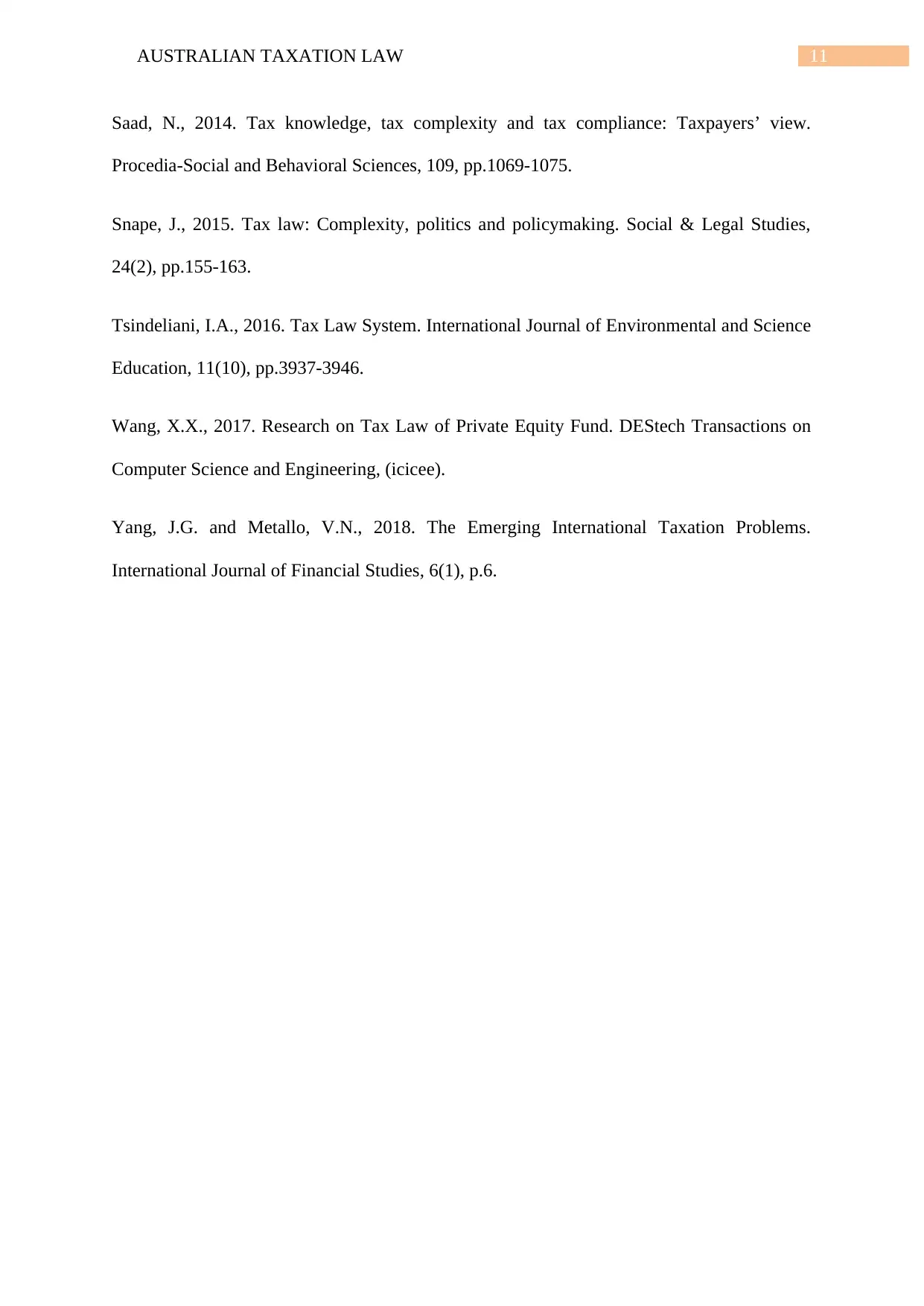
11AUSTRALIAN TAXATION LAW
Saad, N., 2014. Tax knowledge, tax complexity and tax compliance: Taxpayers’ view.
Procedia-Social and Behavioral Sciences, 109, pp.1069-1075.
Snape, J., 2015. Tax law: Complexity, politics and policymaking. Social & Legal Studies,
24(2), pp.155-163.
Tsindeliani, I.A., 2016. Tax Law System. International Journal of Environmental and Science
Education, 11(10), pp.3937-3946.
Wang, X.X., 2017. Research on Tax Law of Private Equity Fund. DEStech Transactions on
Computer Science and Engineering, (icicee).
Yang, J.G. and Metallo, V.N., 2018. The Emerging International Taxation Problems.
International Journal of Financial Studies, 6(1), p.6.
Saad, N., 2014. Tax knowledge, tax complexity and tax compliance: Taxpayers’ view.
Procedia-Social and Behavioral Sciences, 109, pp.1069-1075.
Snape, J., 2015. Tax law: Complexity, politics and policymaking. Social & Legal Studies,
24(2), pp.155-163.
Tsindeliani, I.A., 2016. Tax Law System. International Journal of Environmental and Science
Education, 11(10), pp.3937-3946.
Wang, X.X., 2017. Research on Tax Law of Private Equity Fund. DEStech Transactions on
Computer Science and Engineering, (icicee).
Yang, J.G. and Metallo, V.N., 2018. The Emerging International Taxation Problems.
International Journal of Financial Studies, 6(1), p.6.
⊘ This is a preview!⊘
Do you want full access?
Subscribe today to unlock all pages.

Trusted by 1+ million students worldwide
1 out of 12
Related Documents
Your All-in-One AI-Powered Toolkit for Academic Success.
+13062052269
info@desklib.com
Available 24*7 on WhatsApp / Email
![[object Object]](/_next/static/media/star-bottom.7253800d.svg)
Unlock your academic potential
Copyright © 2020–2025 A2Z Services. All Rights Reserved. Developed and managed by ZUCOL.





